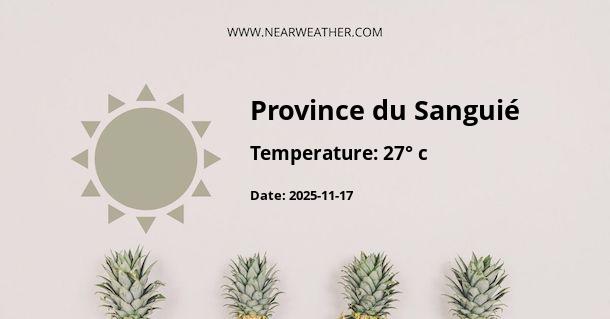Climate and Weather in Province du Sanguié, Burkina Faso
Province du Sanguié is located in the central part of Burkina Faso in West Africa. The province experiences a tropical savanna climate, characterized by distinct wet and dry seasons. The climate of Province du Sanguié is influenced by its proximity to the Sahel region and the West African monsoon.
Temperature
The temperature in Province du Sanguié remains high throughout the year, with average temperatures ranging from 25°C (77°F) to 35°C (95°F). The hottest months are typically March and April, with temperatures often reaching above 40°C (104°F). The coolest months are December and January, with temperatures dropping to around 20°C (68°F) at night.
Here is a table showing the average monthly temperatures in Province du Sanguié:
| Month | Temperature (°C) |
|---|---|
| January | 25 |
| February | 27 |
| March | 31 |
| April | 34 |
| May | 34 |
| June | 32 |
| July | 29 |
| August | 28 |
| September | 30 |
| October | 32 |
| November | 29 |
| December | 26 |
Rainfall
Province du Sanguié experiences a tropical wet and dry climate, with a pronounced rainy season and a long dry season. The rainy season typically lasts from May to October, with the peak rainfall occurring in July and August. During this period, the province receives an average rainfall of around 900mm (35 inches).
Here is a chart showing the average monthly rainfall in Province du Sanguié:
Dry Season
The dry season in Province du Sanguié lasts from November to April, with December and January being the driest months. During this period, the province experiences very little to no rainfall. The dry season is characterized by hot and dusty conditions, with occasional Harmattan winds blowing from the Sahara desert.
Weather Variability
The climate in Province du Sanguié is subject to interannual variability, influenced by regional and global climate patterns. El Niño and La Niña events, for example, can impact rainfall patterns and temperatures in the region. These climate phenomena can lead to periods of drought or excessive rainfall, affecting agriculture and livelihoods in the province.
Impacts on Agriculture and Livelihoods
The climate and weather patterns in Province du Sanguié play a crucial role in the agricultural sector, which is the primary source of livelihood for the local population. Farmers rely heavily on rainfall for crop cultivation, and the timing and amount of rainfall greatly influence agricultural productivity.
The long dry season can pose challenges for farmers, as they need to rely on irrigation or dryland farming techniques to sustain their crops. Conversely, excessive rainfall during the rainy season can lead to flooding and waterlogging, which can damage crops and disrupt agricultural activities.
Efforts are being made to promote climate-smart agriculture practices and improve water management systems in the province to mitigate the impacts of climate variability on agriculture and livelihoods.
Conclusion
Province du Sanguié experiences a tropical savanna climate with distinct wet and dry seasons. The temperature remains high throughout the year, with the hottest months being March and April. The rainy season occurs from May to October, with peak rainfall in July and August. The dry season lasts from November to April, with December and January being the driest months. Understanding the climate and weather patterns in Province du Sanguié is crucial for effective agricultural planning and adaptation strategies.
A - Province du Sanguié's Latitude is 12.166670 & Longitude is -2.666670.
A - Weather in Province du Sanguié is 36° today.
A - Climate Conditions in Province du Sanguié shows few clouds today.
A - Humidity in Province du Sanguié is 16% today.
A - Wind speed in Province du Sanguié is 19.87 km/h, flowing at 86° wind direction. today.
